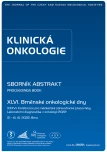Sequencing of microRNAs in brain metastases as a new diagnostic tool
Authors:
M. Večeřa 1; L. Radová 1; F. Siegl 1; M. Smrčka 2; R. Jančálek 3; M. Hermanová 4; M. Hendrych 4; L. Křen 5; J. Šána 1,6; O. Slabý 1,7
Authors‘ workplace:
CEITEC – Středoevropský technologický institut, MU, Brno
1; Neurochirurgická klinika LF MU a FN Brno
2; Neurochirurgická klinika LF MU a FN U sv. Anny v Brně
3; I. ústav patologie, LF MU a FN u sv. Anny v Brně
4; Ústav patologie, LF MU a FN Brno
5; Klinika komplexní onkologické péče LF MU a MOÚ, Brno
6; Biologický ústav, LF MU, Brno
7
Published in:
Klin Onkol 2022; 35(Supplementum 1): 145-147
Category:
Article
Overview
Background: Brain metastases (BM) are the most common intracranial tumors in adult cancer patients. While previously BMs were only treated symptomatically, the approach to therapy is changing due to the increasing incidence resulting from more effective treatment of primary tumors and earlier detection of small asymptomatic BMs. As the prognosis of patients with BM is highly variable, it would be useful to improve diagnostic and prognostic tools by incorporating new powerful biomarkers. MicroRNAs (miRNAs) are promising in this regard and, due to their high stability, suitable both for sequencing (RNA-Seq) and for retrospective analyses in formalin-fixed and paraffin-embedded (FFPE) tissues. Material and methods: Total RNA enriched for miRNAs was isolated from 71 fresh-frozen histopathologically confirmed BM tissues originating from 5 tumor types (lung cancer, 37%; melanoma, 23%; breast cancer, 18%; renal cell carcinoma, 15%; colorectal carcinoma, 7%). Informed consent approved by the local ethics committee was obtained from each patient before treatment. Libraries were prepared from RNA for sequencing on the NextSeq 500 platform (Illumina). Read-to-reference mapping was performed using the tool miraligner and the database miRBase, and differential analysis for 2 437 matured miRNAs was done using the tool limma. MiRNA molecules from total RNA samples isolated from a retrospective set of 119 FFPE tissues were reverse transcribed and the expression of selected differentially expressed miRNAs (miR-122-5p, miR-141-3p, miR-146a-5p, miR-194-5p, miR-200c -3p, miR-211-3p, miR-215-5p, miR-514b-3p, miR-934, miR-1270) was validated by qPCR. Results: Differential analysis identified 373 miRNAs with significantly different expression between the five BM groups (P < 0.001). Subsequent pilot validation verified significantly different expression of selected miRNAs in five BM groups. Conclusion: The presented results confirm the importance of studying dysregulated miRNA expression in BM and the diagnostic potential of validated miRNAs.
Keywords:
neoplasm metastasis – MicroRNAs – Next-generation sequencing – biomarkers – brain neoplasms
Sources
1. Nayak L, Lee EQ, Wen PY. Epidemiology of brain metastases. Curr Oncol Rep 2012; 14(1): 48–54. doi: 10.1007/ s11912-011-0203-y.
2. Sacks P, Rahman M. Epidemiology of brain metastases. Neurosurg Clin N Am 2020; 31(4): 481–488. doi: 10.1016/ j.nec.2020.06.001.
3. Niemiec M, Głogowski M, Tyc-Szczepaniak D et al. Characteristics of long-term survivors of brain metastases from lung cancer. Rep Pract Oncol Radiother 2011; 16(2): 49–53. doi: 10.1016/ j.rpor.2011.01.002.
4. Sperduto PW, Kased N, Roberge D et al. Summary report on the graded prognostic assessment: an accurate and facile diagnosis-specific tool to estimate survival for patients with brain metastases. J Clin Oncol 2012; 30(4): 419–425. doi: 10.1200/ JCO.2011.38.0527.
5. Wu K, Sharma S, Venkat S et al. Non-coding RNAs in cancer brain metastasis. Front Biosci (Schol Ed) 2016; 8(1): 187–202. doi: 10.2741/ s457.
6. Barnholtz-Sloan JS, Sloan AE, Davis FG et al. Incidence proportions of brain metastases in patients diagnosed (1973 to 2001) in the Metropolitan Detroit Cancer Surveillance System. J Clin Oncol 2004; 22(14): 2865–2872. doi: 10.1200/ JCO.2004.12.149.
7. Ostrom QT, Wright CH, Barnholtz-Sloan JS. Brain metastases: epidemiology. Handb Clin Neurol 2018; 149: 27–42. doi: 10.1016/ B978-0-12-811161-1.00002-5.
8. Schouten LJ, Rutten J, Huveneers HA et al. Incidence of brain metastases in a cohort of patients with carcinoma of the breast, colon, kidney, and lung and melanoma. Cancer 2002; 94(10): 2698–2705. doi: 10.1002/ cncr.10541.
9. Kazda T, Kuklova A, Pospisil P et al. Utilization of prognostic indexes for patients with brain metastases in daily radiotherapy routine – is the complexity and intricacy still an issue? Klin Onkol 2015; 28(5): 352–358. doi: 10.14735/ amko2015352.
10. Kakimoto Y, Tanaka M, Kamiguchi H et al. MicroRNA stability in FFPE tissue samples: dependence on GC content. PLoS One 2016; 11(9): e0163125. doi: 10.1371/ journal.pone.0163125.
11. Peiró-Chova L, Peña-Chilet M, López-Guerrero JA et al. High stability of microRNAs in tissue samples of compromised quality. Virchows Arch 2013; 463(6): 765–774. doi: 10.1007/ s00428-013-1485-2.
12. Daugaard I, Venø MT, Yan Y et al. Small RNA sequencing reveals metastasis-related microRNAs in lung adenocarcinoma. Oncotarget 2017; 8(16): 27047–27061. doi: 10.18632/ oncotarget.15968.
13. An M, Zang X, Wang J et al. Comprehensive analysis of differentially expressed long noncoding RNAs, miRNAs and mRNAs in breast cancer brain metastasis. Epigenomics 2021; 13(14): 1113–1128. doi: 10.2217/ epi-2021-0152.
14. Hanniford D, Zhong J, Koetz L et al. A miRNA-based signature detected in primary melanoma tissue predicts development of brain metastasis. Clin Cancer Res 2015; 21(21): 4903–4912. doi: 10.1158/ 1078-0432.CCR-14-2566.
Labels
Paediatric clinical oncology Surgery Clinical oncologyArticle was published in
Clinical Oncology

2022 Issue Supplementum 1
- Metamizole vs. Tramadol in Postoperative Analgesia
- Metamizole at a Glance and in Practice – Effective Non-Opioid Analgesic for All Ages
- Possibilities of Using Metamizole in the Treatment of Acute Primary Headaches
- Current Insights into the Antispasmodic and Analgesic Effects of Metamizole on the Gastrointestinal Tract
- Spasmolytic Effect of Metamizole
Most read in this issue
- VIII. Radioterapeutické metody a radiofarmaka
- XXVIII. Neuroendokrinní a endokrinní nádory
- IV. Follow-up, sledování onkologických pacientů
- XXII. Nádory slinivky, jater a žlučových cest
